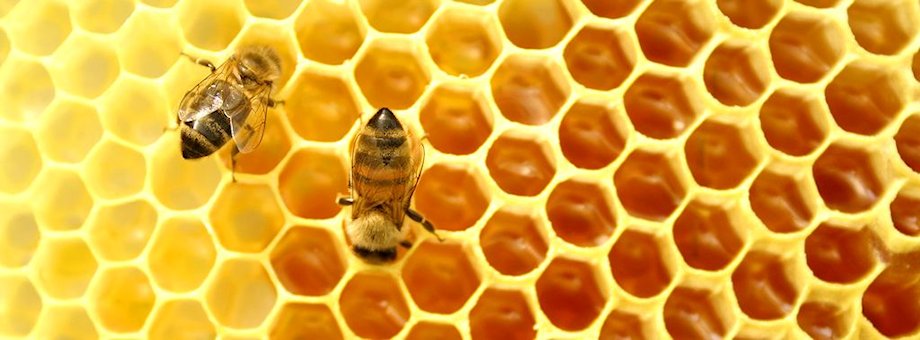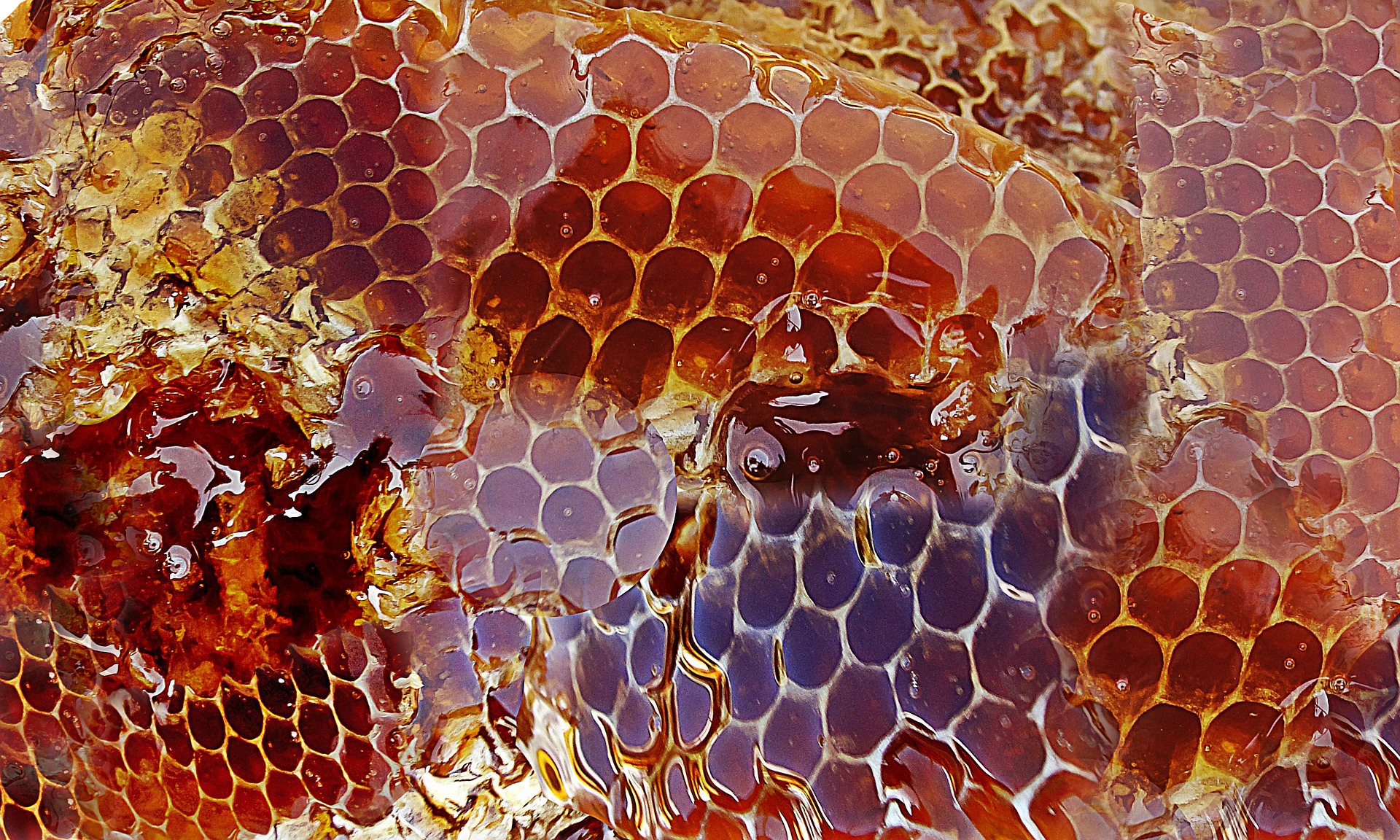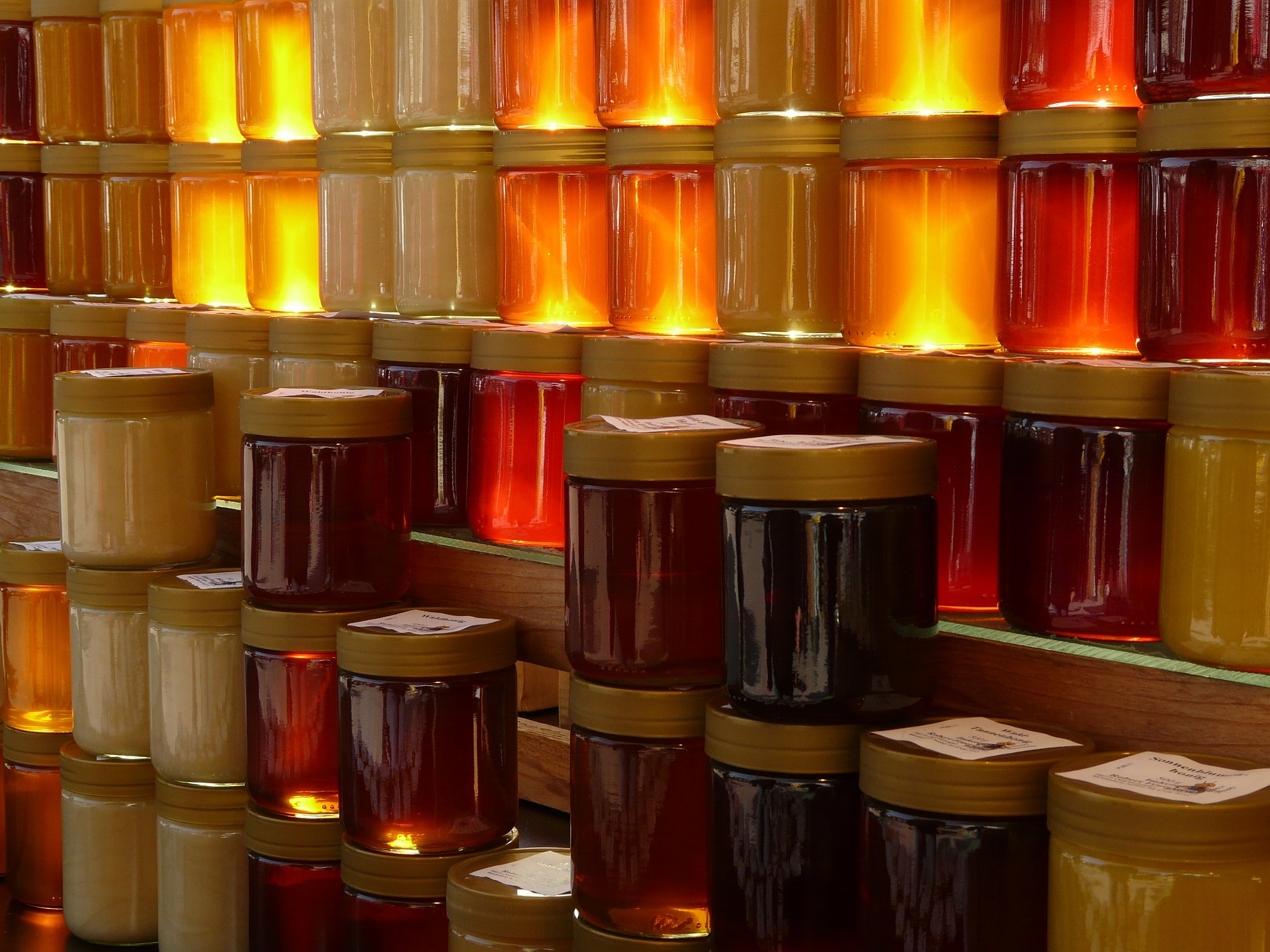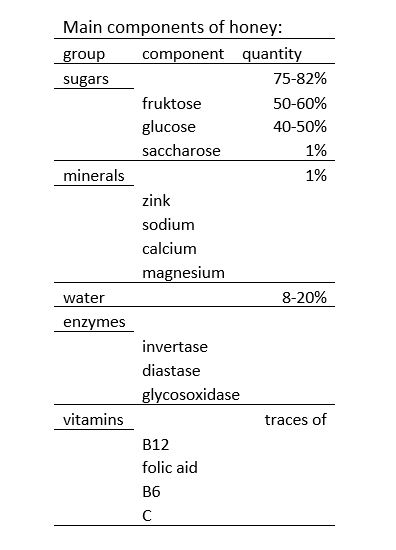
The evolution of the need-based nutrition of the human organism was closely related to opportunities and the best possible use of energy. Access to honey used to be limited, depending greatly on the vegetation period of nectar producing plants. This means that honey used to play an important yet only additional role in human nutrition. We can be confident that in earlier periods of history, man consumed honey not as staple food but as supplementary food consumed only for enjoyment. In some isolated tribes, men continue to offer women and children honey as a gift. Most probably, honey (along with fruits) contributed to the evolution of man’s “incentive” attraction to the sweet taste.
Honey is produced not only by bees. Some ants also collect honey, storing it in their huge abdomen to prepare for years when food is scarce. Bees, however, are more wide-spread and, contrary to ants, live in every region of the world except for the polar regions. There are many species of animals which look for beehives and form an interesting relationship with bees. For example, a bird called the greater honeyguide guides the honey badger to bees, and once the badger eats the honey, the greater honeyguide consumes the larvae. In some regions, African indigenous people follow the greater honeyguide, while the honeyguide learnt to cooperate with men to get delicious food.

Honey badger
Source of image: www.wilkinsonsworld.com
These facts show that mankind had known honey long before the era of agriculture began. Some thousands years ago, we domesticated wild bees and multiplied the available quantity of honey. Still, the amount of honey produced and consumed globally remains only a fraction of that of sugar. The price of honey also limits global consumption. However, it is increasingly clear from scientific studies and knowledge that honey remains the only sweetener that has been proven to be free of adverse health effects.
Until the industrial-scale production of cane sugar and beet sugar started, honey had been the only available sweetener. Sugar production commenced in India and started to spread very slowly, from the 4th-7th centuries onwards. Sugar was considerably cheaper than honey, and slowly but surely started to increase its market share. The industrial revolution, along with the fact that the human being likes the sweet taste above all, brought about a breakthrough in sugar production and a gradually expanding demand for sugar. At the end of the 19th century, other artificial sweeteners were introduced and their large-scale production started. Currently, the two main types of sugar consumed are white sugar (beet sugar or crystal sugar) and fructose. Fructose does not denote fruits as a source of sugar, but artificially produced industrial fructose. White sugar or crystal sugar is a commodity of which approximately 180 million tons were produced in 2014, to which the amount of artificially produced fructose needs to be added. As for artificial fructose, it is very difficult to find reliable data, but the estimated amount is 50% of the white sugar consumed. This means that mankind consumes approximately 270 million tons of sugar and fructose syrup every year, excluding non-sugar artificial sweeteners. By contrast, global honey consumption was approximately 1.8 million tons in 2014. This means that the amount of honey consumed is less than 1% of sugar consumed.
Industrial sugar beet processing Source of image: https://www.flickr.com/photos/lifesgreatadventures/5255871278/
This article is intended to give a detailed presentation of the advantages of honey. In summary, a basic observation is that honey does not pose any risk to the health, while every other sweetener does. From this perspective, human attraction to the sweet taste entails a major global health risk, given that in the last 200 years this very real market demand has basically been met with artificial substances with adverse health effects. Another, even more alarming fact is that children and adolescents consume the largest quantities of health-endangering sugars and artificial sweeteners. (NHANES III, Third National Health & Nutrition Examination Survey). This is also true (or even worse) for Hungary.
When analysing the role honey can play in human nutrition, three sub-questions need to be discussed.
- Does honey have any adverse health effects when used as a sweetener?
- Compared to those of other sweeteners and sugars, what are the advantages of honey?
- How can honey promote health maintenance?
To give a reliable answer to these questions, let us start with the chemical composition of honey. As far as its main components are concerned, honey is unique, as it consists almost exclusively (98%) of monosaccharides or single-molecule sugars. There is no other substance that is available in nature and consists of single-molecule sugar or sugars. These facts result in characteristics which set honey very clearly apart from other sugars. Its water content is significantly high, around 8-20%. Its mineral and vitamin content is very low. It is to be noted that bees add various enzymes to honey that, upon entering the gastro-intestinal tract, promote digestion, provided that the honey was not heated or baked before it. It is also worth mentioning that honey may contain many other substances besides those discussed above, which gives it a local character depending on the given region (e.g. special minerals or vegetable alkaloids). Such substances may give interesting, unique or even exciting flavours to the honey, but may also cause fatal poisoning. An example for the latter is “mad honey”, originating from the Black Sea region, which may contain large quantities of grayanotoxin produced by Rhododendron flavum, along with other toxic substances collected by bees from plants of the heather family (Ericaceae) or the soapberry family (Sapindaceae). Mad honey may cause nausea, vomiting or hallucinations, or, according to some observations, reversible heart failure.

Its flowers are pleasing to the eye, but you had better avoid its honey.
Rhododendron luteum (yellow azalea)
Source of image: https://commons.wikimedia.org/wiki/File:Rhododendron_luteum.jpg
Now let us see the questions which will give an insight into the importance of the use of honey as a sweetening matter.
1. Does honey have any adverse health effects when used as a sweetener?
No, it does not. It is another clear fact that among sweetening matters honey is the only one which does not have adverse health effects on the human organism, provided (and this is to be emphasised) that it is used as a sweetening matter. Relevant technical literature does not contain any experiment or practical observation that challenges this statement. Moreover, it is important to note that this holds true for people with diabetes as well. The last section of this article will discuss the matter in some detail. At this point, let us note that honey is the ideal sweetening matter for people with diabetes. Medical sciences have documented a large number of positive effects of honey. Evidently, some of them are exaggerations, as no favourable impacts have been proven for the cold, cough or upper respiratory infections. Yet honey can be used very successfully for wound management, given that it hinders the multiplication of pathogens due to its very high monosaccharide content. However, we must be sceptical about its often-cited favourable impact on enteric symptoms, such as the alleged blood pressure reduction or “blood cleansing”. But this is not why honey is the ideal sweetening matter.

Source of image: https://pixabay.com
2. Compared to those of other sweeteners and sugars, what are the advantages of honey?
There are various reasons why honey is better than other sweetening matters. The first reason concerns its composition. To understand this point, a key fact about fructose absorption needs to be taken into account. In the intestinal lumen, fructose concentration is low. The intestinal epithelium cells produce fructose from glucose, which means that fructose is used locally and ATPs (high-energy molecules) are produced. If the fructose concentration grows in the intestinal lumen, the intestinal epithelium cells transfer fructose to the blood plasma; therefore, fructose is not used locally (in the intestines). In the course of the metabolic process, the absorbed fructose moves in the “wrong” direction, which has several heavily studied consequences. It is estimated that the consumption of more than 20g fructose at a time has serious unfavourable effects such as high blood pressure, increased inflammatory factors, increased uric acid level, weight gain, strong sense of hunger and chronic fatigue syndrome (continuous tiredness). Such effects are caused by the consumption of any food sweetened with fructose syrup (corn syrup) or by the excessive consumption of fruits. The latest studies discuss the carcinogenic potency of fructose more and more often. Unfortunately, even not long ago, fructose as a sweetening matter was recommended for people with diabetes. Presumably, the kidney damage of people with diabetes can be associated with fructose consumption. The consumption of honey does not result in such adverse effects given that in honey the ratio of fructose and glucose is ideal.
White sugar (crystal sugar or powdered sugar) often causes bloating due to the fact that, unlike honey, it does not contain monosaccharides, but disaccharides (double sugars) which need further processing in the intestinal tract. This capacity of the human organism is highly variegated, depending on the amount of the degrading enzymes it can produce. In the civilised era, this capacity is almost invariably decreased. Consequently, white sugars often cause bloating to greater and lesser extents due to the gas formation in the stomach and the intestinal tract.
Evidently, honey is healthier than white sugar produced from natural raw materials. According to current studies, fructose syrups are also less healthy than honey.
Sugar alcohols are gaining ground in trade. The two most common types of sugar alcohols are xylitol and erythritol. Of the two, xylitol has been studied more extensively. An analysis of the first studies (performed in the 70s and 80s) shows that several unpleasant symptoms were described and the issue of carcinogenic potential was also discussed. The latter was corroborated by an experiment performed at the University of Pécs, Hungary. It is to be noted that in the course of the experiment other sweetening matters were also studied with animal trials, and the issue of carcinogenic potential was raised in the case of every substance. There is yet another problem with sugar alcohols. Normally, sugar alcohols (including xylitol) are produced from stalks (e.g. corn stalk) with various chemical treatments, and the process has a problematic part. During heating and chemical treatments, various sugar alcohols are produced in plants some of which (e.g. galactitol) have clear adverse effects on human health, for instance, they may cause cataract or liver damage. Therefore, xylitol should be produced only in its pure form, but only a few factories can guarantee that. In most cases, the xylitol produced in Asian factories and shipped to and packaged in Europe contains galactitol, which has adverse health effects, especially in newborn babies. Obviously, other sugar alcohols do not necessarily have the same alleged effects as xylitol, but experience shows that they also cause problems such as bloating or diarrhoea, or, in some cases, liver damage. The relevant Hungarian technical literature also presents such cases. As evidenced by our experience of several years in Hungary, xylitol and erythritol cause significant adverse reactions.
Therefore, based on scientific studies and our own experience, it can be concluded that the consumption of sugar alcohols may have adverse health effects. In all respects, honey is better than any sugar alcohol.

Source of image: https://pixabay.com
The next section discusses artificial sugar substitutes. Some of them consist of molecules that are present in nature, still, they are the end products of complex chemical processes. The four most frequently used artificial sugar substitutes are as follows:
- saccharin
- acesulfame K
- cyclamate
- aspartame
To some degree, all of them have been associated with adverse health effects. Saccharin has been linked to an increased frequency of bladder cancers, corroborated by multi-generational animal trials. Consequently, Canada and the USA withdrew its marketing authorisation. In 1991, its use was permitted again; however, its packaging must indicate potential adverse health effects. Acesulfame K had genotoxic effects on rats, causing thyroid tumours. As for aspartame, studies described the increased frequency of a specific type of lymphatic cancer in rats. In humans, it may cause headache, nausea or vomiting. Cyclamate increased the frequency of the occurrence of bladder cancers. It is to be added that sweetening matters consisting of natural components were also reported to have adverse health effects, and although the majority of information comes from animal trials, this is in itself a serious warning. If there is a much better option, we had better avoid substances with dubious trial results. The Hungarian study performed by the University of Pécs, mentioned above, has recently concluded that with regard to artificial sugar substitutes and sugar alcohols increased carcinogenesis must be taken into account.
It is to be concluded that honey is a better option than artificial non-sugar-based sweeteners. None of the artificial sugar substitutes can be regarded as completely safe. Honey, by contrast is undoubtedly safe.
3. How can honey promote health maintenance?
In long-term health maintenance, we must not rely on the positive effects on honey. Honey is important, as it is completely safe and does not have adverse health effects; however, in itself it does not have medicinal effects. If you use honey instead of the currently popular sweetening matters, then you can completely avoid their adverse effects – but, obviously, only those which would have been caused by their consumption. Honey cannot prevent cardiovascular diseases or diabetes. Instead, it can be one element of a healthy diet as the single sweetening matter that does not have adverse health effects. This means that a healthy lifestyle must include the consumption of honey and exclude any other sweetening matter. It must be noted that you consume artificial sugar substitutes not only with tea or coffee. The majority of commercially available food contains sweetening matters in some form, including meat products which many of us would think to be free of such substances.
It can be unambiguously stated that substituting honey for artificial sweetening matters significantly reduces individual and public health risks.
We must re-evaluate some basic issues of nutrition to understand that people with diabetes can greatly benefit from re-introducing honey in their diet as a sweetener. People with diabetes are advised not to consume honey due to its glycemic index and the blood glucose rise it causes. However, based on the results of our researchers’ team and our experience with patients, we are convinced that the glycemic index and the blood glucose rise are not related to the onset and complications of diabetes. In itself, the glycemic index of foodstuff does not give information about healthiness and, in itself, the blood glucose rise is not significant as far as diabetes is concerned. For people with diabetes, problems arose from the increase of inflammatory factors and the extreme consumption of carbohydrates. In the diet of an average person with diabetes, honey used as sweetening matter makes up only approximately 10% or less of all carbohydrates consumed. Therefore, in our view, there are no scientific grounds for prohibiting people with diabetes from the consumption of honey. By contrast, the use of other sweeteners entails many risks for people with diabetes. This is particularly true for fructose, which is still available on prescription in pharmacies, even if its use has been proven to entail very serious risks. Due to the length limitations of this article, these statements are not discussed in detail. Recent studies have also shown that the use of artificial sugar substitutes does not contribute to weight loss in people with diabetes. Quite the contrary.
We recommend that people with diabetes use honey instead of artificial sugar substitutes, as honey offers significant benefits compared to other sweeteners.
Please note that this article analyses the use of honey as a sweetener, which means that the daily consumed amount does not exceed 20g.
Obviously, the total amount of sugar and artificial sweeteners produced globally cannot be substituted with honey. It is simply not possible to produce that much honey – or even a fragment of it. What we can do is to utilise Hungary’s strengths, and keep and sell the honey originally produced for export in Hungary. However, this requires, firstly, a general raising of awareness of the risks of sugar consumption and a re-interpretation of legislative acts and decrees on food trade.
References:
- Édesítőszerek hatásának vizsgálata in vivo biológiai rendszerekben. PhD dissertation, Mrs László Tamár Ungár, Éva Polyák
- Paleolit Orvoslás Budapest 2012 (Jaffa), dr. Csaba Tóth
- The Potential Toxicity of Artificial Sweeteners Christina R. Whitehouse, BSN, RN, Joseph Boullata, PharmD, RPh, BCNSP, and Linda A. McCauley, PhD, RN, FAAN, FAAOHN
- Artificial Sweeteners: A systematic review of metabolic effects in youth Rebecca J. Brown, Mary Ann De Banate, Kristina I. Rother
- Adverse effects of xylitol in parenteral alimentation William Schumer 1970
- The scolicidal effects of honey Bulent Kilicoglu MD, Kemal Kismet MD, Ozgur Koru MD, Mehmet Tanyuksel MD, Mehmet Tahir Oruc MD, Kadriye Sorkun PhD, Mehmet Ali Akkus MD
- A fruktóz története, Irodalmi áttekintés, Dr. György Biró 2011, Egészségtudomány
- Nutraceutical values of natural honey and its contribution to human health and wealth
- Abdulwahid Ajibola, Joseph P Chamunorwa and Kennedy H Erlwanger 2012
- Crane E: History of honey. In Honey, A Comprehensive Survey. Edited by Crane E. London: William Heinemann; 1975
- http://tudastar.elelmiszerklub.hu/2013/11/aki-cukorfogyasztasa-2-szazalekkal.html
- http://hu.wikipedia.org/wiki/M%C3%A9z
Author: dr. Csaba Tóth
The author is an MD and general practitioner with 20 years of experience in internal medicine and intensive therapy, co-founder of Paleomedicina and author of the book “Paleolit orvoslás” (“Paleolithic Medicine”).
The article in Hungarian / A cikk magyarul
Paleomedicina working group performs its activity exclusively on a scientific basis. We do not use methods of naturopathic medicine, and distance ourselves from such practices. Paleomedicina represents evolutionary medicine, a branch of real, evidence-based science. For our publications published in international medical journals, please click here.
2020-05-09
 Rehabilitáció csak online elérhető
Rehabilitáció csak online elérhető
 E-mail: paleomedicina@gmail.com
E-mail: paleomedicina@gmail.com




